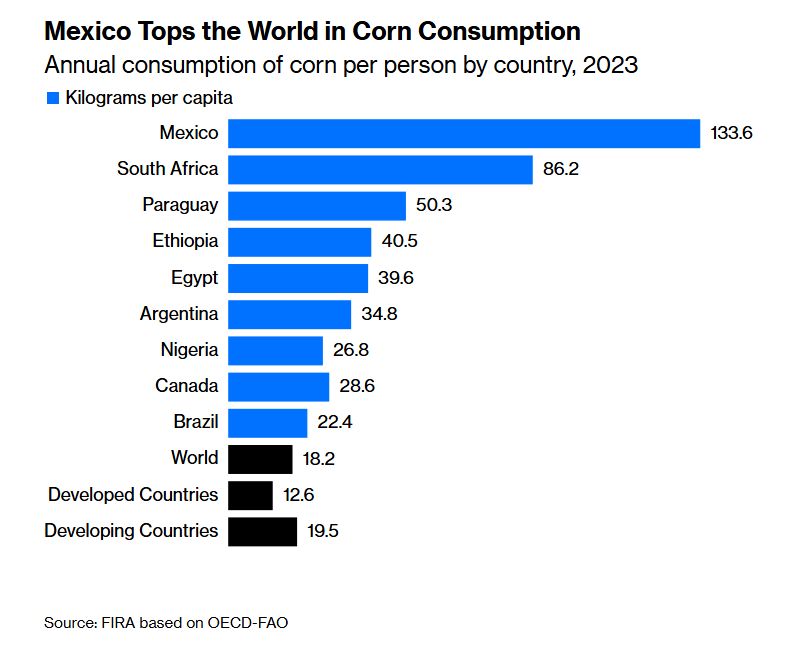A Corn Crisis Is Brewing in Mexico

Few things are more revered in Mexico than corn.
This staple crop is both a cultural symbol and a cornerstone of national identity, with roots stretching back to pre-Hispanic times. Indigenous groups regard it as a gift from the god Quetzalcóatl; whatever its provenance, the corn tortilla remains a fixture of everyday Mexican life. “Sin maíz no hay país” — “without corn, there is no country” — is a saying that former president Andrés Manuel López Obrador’s nationalist movement has amplified since he took office in 2018.
The problem is that, like many national symbols, corn can’t live up to the myth forever. Mexicans are by far the world’s largest consumers of corn per capita, to the point that domestic production can no longer meet demand. The country increasingly relies on imports of yellow corn, mostly from the US, to feed livestock and supply industrial uses, while reserving its prized white corn for household consumption.
Rising temperatures, poor yields, recurring droughts and a constitutional ban on genetically modified crops have all deepened Mexico’s dependence on US corn. Imports are expected to cover roughly half of total consumption in the 2024/2025 season, up from about a third a decade ago, while local output remains broadly stagnant.
Mexico’s Reliance on Corn Imports Keeps Rising
Domestic production and imports of corn by metric ton
President López Obrador and his successor, Claudia Sheinbaum, have sought to secure self-sufficiency in white corn by guaranteeing minimum prices for small farmers, those with plots of up to five hectares (12.4 acres), while promoting native varieties. But a bumper US harvest this year has pushed down global prices, squeezing Mexican producers struggling with higher costs and mounting rural violence.
After brewing for months, the conflict erupted this week as farmer groups blocked roads and highways across the country to pressure the government for more support. Just as the protestors were set to reach Mexico City, Sheinbaum’s administration agreed to new subsidies and credit facilities, along with a framework to set reference prices and facilitate direct agreements between farmers and large buyers.
Crisis averted — for now. The truth is that corn is a growing headache for Mexico. And if current consumption, production, weather and policy trends persist, the problem will only deepen. The mix of unorthodox measures, dirigisme and misconceptions is untenable: Mexico cannot simultaneously expand output, subsidize small farmers at the expense of larger operations, champion native seeds, ban genetically modified corn and still claim to guarantee food sovereignty. Something has to give.
Of course, the country is hardly alone in subsidizing its farmers — agriculture is politicized everywhere. Some financial support is inevitable, even justified. But the government should let market forces correct part of the distortion instead of deepening interventions under the threat of roadblocks and unrest. By fixing guaranteed prices for small producers, it undermines the economies of scale modern farming needs to boost efficiency and productivity. Forcing large buyers to pay more for corn will drive final prices higher — sooner rather than later. In many ways, Mexico’s corn policy mirrors its approach to another national icon, oil giant Pemex: plenty of symbolism and goodwill, but little economic rationality.
The ban on planting genetically modified corn is especially harmful — arguably one of Lopez Obrador’s biggest policy own goals, and he’s had plenty. It leaves Mexican farmers at an even greater strategic disadvantage by denying them access to higher-yield, more resilient seeds and increasing dependence on US imports. Mexico even lost a USMCA arbitration panel last year for failing to provide scientific evidence to justify halting GMO corn imports from its northern neighbor. Ironically, millions of Mexicans still consume GMO corn indirectly every day through meat and other products fattened with American feed.
Because the ban is now enshrined in the constitution, reversing it will be politically impossible for years. But as a president with a scientific background, Sheinbaum needs to find ways to at least mitigate its economic damage.

Worst of all, at a time when international corn prices have fallen about 10% since February and the peso has strengthened, Mexican consumers can’t enjoy the lowest domestic prices since 2017. On the contrary, tortilla prices are likely to rise between 15% and 20% in the coming months due to mounting cost pressures, Homero López García, president of the National Tortilla Council, tells me. That will accelerate inflation, given the tortilla’s heavy weight in the consumer basket.
The outlook for agriculture is even tougher. Rising temperatures and recurring droughts will hit local harvests. That’s another reason to invest in technology and economies of scale. There’s much that both government and the private sector can do to modernize Mexico’s outdated irrigation systems and strengthen water management. Supporting family farming and promoting native maize are laudable goals, but they won’t deliver the huge output and productivity increases needed to reduce the nation’s dependence on corn imports. On the contrary, they could even undermine Mexico’s food sovereignty by exposing the country to geopolitical swings.
If Mexico wants to save its national symbol, it needs to put more of its faith in market forces and a little less of it in Quetzalcóatl.
For almost 30 years of expertise in the agri markets, UkrAgroConsult has accumulated an extensive database, which became the basis of the platform AgriSupp.
It is a multi-functional online platform with market intelligence for grains and oilseeds that enables to get access to daily operational information on the Black Sea & Danube markets, analytical reports, historical data.
You are welcome to get a 7-day free demo access!!!
Write to us
Our manager will contact you soon



